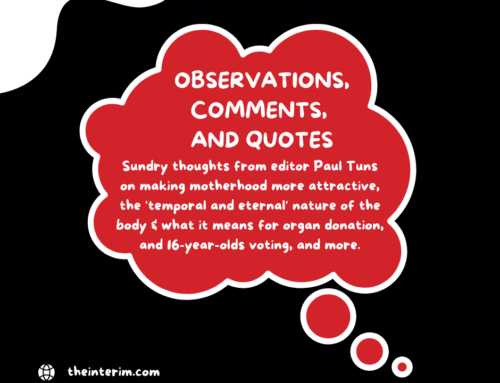Paul Tuns, Review:
Life in the Negative World: Confronting Challenges in an Anti-Christian Culture
by Aaron Renn (Zondervan, $33.50, 247 pages)
 Aaron Renn is a fellow at American Reformer and former research fellow at the right-of-centre Manhattan Institute for Public Policy. You might be familiar with his work if you are regularly reader of First Things, his subscription newsletter or his Substack. His new and challenging book Life in the Negative World: Confronting Challenges in an Anti-Christian Culture expands his 2022 First Things essay “The Three Worlds of Evangelicalism” in which he identified three ages in which evangelicals (and the broader Religious Right, pro-life, and social conservative movement) have lived through over the past six decades and the various responses to those different ages and their unique challenges. Although he writes primarily about and for evangelicals, there are broader lessons for all people of faith who hold true to traditional virtues and religious practices.
Aaron Renn is a fellow at American Reformer and former research fellow at the right-of-centre Manhattan Institute for Public Policy. You might be familiar with his work if you are regularly reader of First Things, his subscription newsletter or his Substack. His new and challenging book Life in the Negative World: Confronting Challenges in an Anti-Christian Culture expands his 2022 First Things essay “The Three Worlds of Evangelicalism” in which he identified three ages in which evangelicals (and the broader Religious Right, pro-life, and social conservative movement) have lived through over the past six decades and the various responses to those different ages and their unique challenges. Although he writes primarily about and for evangelicals, there are broader lessons for all people of faith who hold true to traditional virtues and religious practices.
Renn argues that there was a Positive World, Neutral World, and Negative World that animated the broader culture’s relationship to Christianity. The Positive World, in place from the early 1960s through to the early 1990s, privileged Christian practice and beliefs, a status “softly institutionalized” by laws that upheld Christian morality and the social expectation that a good citizen was also likely a church-going and moral person. “Christianity and church attendance had normative force in society.” Much of this was due to the traditional White Anglo-Saxon Protestant (mainline Protestantism) or WASP culture that sat atop the U.S. political, economic, and cultural hierarchy. Renn says that there were people who had no interest in the tenets of faith who attended church services simply because that was what was expected but it maintained a status quo in which “Christianity was held in honour.” It should be noted that during this time, there was already immense secularizing pressures.
This was followed by a brief period Renn labels the Neutral World in which society became neutral toward Christianity, with religious piety and morals no longer holding a “privileged status but nor was it disfavoured.” Christianity, Renn argues, was “one valid option among many within a pluralistic, multicultural public square” and “Christian moral norms retain some residual effect.” This period was relatively short-lived, with Renn dating it from 1994 through 2014.
The present Negative World is one in which Christian practice and ethics are viewed with disdain when they do not coincide with progressive ideology, and “Christian morality is expressly repudiated and now seen as a threat to the public good and new public moral order.” There are negative consequences for professing one’s faith including a loss of status and sometimes livelihood. “The contents of a person’s Christian faith,” Renn argues, “can’t conflict with today’s secular culture and ideologies” so that “denatured Christianity is acceptable but orthodox Christianity is not.” That is, you are allowed your faith if it is entirely private and does not influence what you do outside church.
The advent of the Negative World coincides with what is sometimes called The Great Awokening that was animated by a new lexicon of “social justice, systemic racism, and white privilege” that made the jump from the halls of academia to the pages of the nation’s newspapers and social media in 2014.
Renn identifies six key factors leading to a decline in the status of Christianity: the collapse of the WASP establishment, the ‘60s social revolution, the ‘60s sexual revolution, the end of the Cold War, deregulation and corporate consolidation, and digitization.
There were three distinct evangelical responses to the decline in receptivity to Christianity: culture war, seeker sensitivity, and cultural engagement. With growing secularism during the Positive World, there was a culture war strategy of “highly combative” political engagement by the Religious Right and a seeker sensitivity strategy which “reposition(ed) the church to be more relevant to changing consumer tastes in order to increase their market” appeal. Renn says that seeker sensitivity Christianity was often presented in a “therapeutic register” to make churches “more approachable and non-threatening to non-churchgoing people in the broader culture.” Many of these churches aligned politically with culture warriors even if they were less outspoken about it.
The third strategy, cultural engagement, “tended to downplay flashpoint social issues like abortion or homosexuality,” emphasizing Jesus and Gospel “often in a therapeutic register similar to seeker sensitivity” churches. But these churches tended to prioritize issues more in line with secular society like social justice and alleviating poverty.
Renn says that the culture warrior strategy was more rural, seeker sensitivity strategy was more suburban, and the cultural engagement strategy was more urban. There are often clear class distinctions and each had positives and negatives, and the trick Renn says is to learn what is most applicable in the Negative World. (Cultural engagement church leaders and congregants had the most to lose as they generally populated the cities where large numbers of economic and cultural elite live and work.)
There are challenges for church mission going forward. The culture warriors, for example, “has been forced to confront a culture not amendable to being transformed through politics.” The most immediate questions, however, are not necessarily about saving the culture but saving spaces for Christians to practice they faith without compromise with the anti-Christian culture.
Renn offers a program, often more general than specific, for Christian believers to essentially make safe spaces for themselves so that they can persist and someday again be salt and light in the world. Not only are Christians a moral minority, but secular culture is intent on ensuring that it has no public purchase. This adjustment will be personal, institutional, and missional.
Renn wonders “how many of us ever considered whether our faith might cost us our job or was a barrier to advancement in our profession?” Increasingly practicing Christianity is a risky venture and Renn preaches resilience through a number of strategies. One strategy is “becoming excellent” in the professions and to avoid eschewing intellectual work so some Christians rise to positions of importance in secular society without “affirming absurd positions.” “Christian life in the negative world,” Renn writes, “will require more intentionality, focus, and effort than before.” But an insurance policy doesn’t hurt and Renn counsels that Christians save a significant portion of their income for when they will have to choose between their job and Christ, and that means living frugally, staying and getting out of debt, and becoming financially independent. That will allow them to walk away from a job when they refuse to affirm secular pieties over Christian ones. He also advises Christians becomes landowners and entrepreneurs as both insurance against cancellation and to help those Christians that are pushed out of secular society and its marketplace for staying true to their faith. This, Renn says, is “equipping not insulating” Christians to be truly countercultural. A Christian-owned café or bookstore that refuses to display the rainbow flag is an important venue for resisting the relentless politicizing pressures on both consumers and other businesses.
Furthermore, Renn says that Christians need to repair their “sexual economy” which means resisting pressure to divorce, having smaller families, or avoiding marriage and children altogether, as well as the viewing of pornography and normalizing casual sex. Renn provides the statistics to show that Christians are hardly immune to the sexual immorality rampant in the broader culture. “We should seek to create a counterculture in the church that models God’s intended created order and Christian teaching” and model that counterculture to a broken world. “We must first live out God’s ways in our own lives, families, and churches” and “only then, and only by God’s grace, will we have any future hope of bringing change to secular society.” He specifically calls out pastors who downplay the importance of marriage out of fear of offending single men and women in their congregations and emphasizes that “singlehood has never been understood as an ordinary calling for large numbers of Christians.”
Renn says that “online gurus” like Jordan Peterson have attracted large followings by speaking bold truths and says that “bold yet not gratuitously offensive honesty is attractive to those hungry for truth.” It is a model for missional churches to speak clearly about the challenges of modern society.
Healthy Christian families and communities will be countercultural in the Negative World but they will also attract souls seeking the Truth among the unchurched. Renn emphasizes that gender and the denial of biological sex is an important area in which the world is crying out for realism but that evangelicals intellectual teaching on the subject has been neglected. It is an area of immediate need for “excellence” that Renn calls for.
Life in the Negative World counsels against disengagement and retreat but also says that recent strategies to engage have been ineffective and need to be rethought. He says that the near future is fraught with the unknown dangers that increased intolerance, suspicion, and hostility toward Christianity will present to Christian believers but that complacency in the old ways or retreat from a corrupted world are not answers to the challenges evangelicals and all practicing Christians face in the Negative World.




